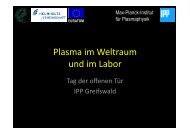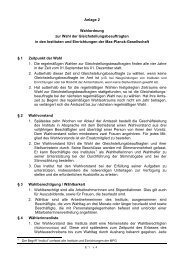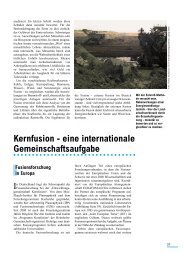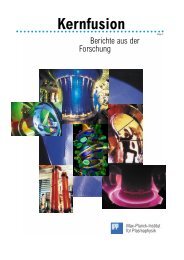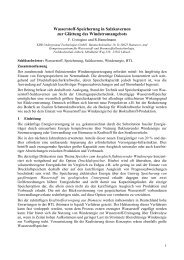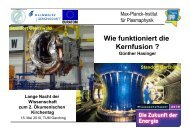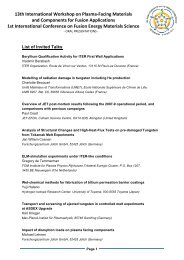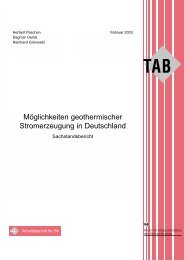IPP Annual Report 2007 - Max-Planck-Institut für Plasmaphysik ...
IPP Annual Report 2007 - Max-Planck-Institut für Plasmaphysik ...
IPP Annual Report 2007 - Max-Planck-Institut für Plasmaphysik ...
You also want an ePaper? Increase the reach of your titles
YUMPU automatically turns print PDFs into web optimized ePapers that Google loves.
diameter (instead of originally 73 mm) and a surface curvature<br />
radius of 350 mm (instead of 1100 mm) are loaded with<br />
the same stresses and strains as the full sized ones by applying<br />
only 10 % of the compression force. The scaling is based<br />
on extensive FE calculations. With the BAM equipment,<br />
experiments can be performed much cheaper and quicker as<br />
with the full size samples which were necessary during the<br />
development phase. An additional advantage of the BAM<br />
test bed is its suitability for experiments in liquid helium.<br />
However, for achieving completely realistic environment<br />
conditions, the equipment needs to be upgraded for vacuum<br />
operation at 5 K and 80 K. The tests performed so far did<br />
not completely confirm the previous full scale tests at KRP<br />
which were done in vacuum at 80 K. Surprisingly, no stick<br />
slip occurred during tests in LN 2 up to 15000 load cycles,<br />
but stick slip was immediately present at the experiments in<br />
LHe and ceased after about 50 cycles. This behaviour was<br />
the same for MoS 2 -sprayed and -burnished counter-sides. In<br />
order to clarify this issue tests in vacuum at these temperatures<br />
would be necessary, however, the complete test program<br />
is not yet finally decided. Systematic pad and counterside<br />
MoS 2 layer ageing experiments were started in order to<br />
estimate possible impact of the long exposure to air during<br />
W7-X assembly. In order to reduce such ageing risks, in the<br />
assembly as well as the torus hall the air humidity is kept<br />
below 50 %. NSE pad and counter-side layer application<br />
was supervised, and non-conformities were evaluated as<br />
well as corresponding decisions prepared. In this context a<br />
specification for tolerable defect sizes of sliding surfaces<br />
was created.<br />
4.2.2 Coil quench experiment<br />
Detailed preparation of the intended experiment to mechanically<br />
excite a non-planar coil by hitting it in cryogenic environment<br />
under self-field magnetic load was started after<br />
general consent for such an experiment was achieved within<br />
<strong>IPP</strong>, with CEA Saclay, and with the coil manufacturer BNG.<br />
The basic experimental procedure was decided, and preparatory<br />
experiments were started. The real mechanical quench<br />
experiment in Saclay is planned for autumn 2008 within an<br />
available time window of the coil test schedule.<br />
4.2.3 Materials<br />
The material data base was maintained and continuously<br />
supplemented as an ongoing activity. Cryogenic tensile tests<br />
of welds and weld influence zones of cold- and warm-hardened<br />
aluminium alloy conductor jacket material were done.<br />
Orthotropic mechanical characteristics (stress-strain as well<br />
as thermal contraction) of fibre-glass epoxy samples of the<br />
bus-bar weld joint insulation were determined at liquid<br />
helium temperature. Microstructure investigations and cryogenic<br />
tensile tests were performed on a new Al-bronze alloy<br />
for NSE/PSE/CE pad material, and further low temperature<br />
Wendelstein 7-X<br />
44<br />
pulling tests on high-quality steel (1.4429 ESU) for highly<br />
loaded NSE pad frames. All these cryogenic tests were carried<br />
out at the FZK. Collection and classification of coil<br />
housing cast defects was almost completed.<br />
4.3 Instrumentation<br />
New strain gauge sensors with reduced temperature dependence<br />
in cryogenic environment were introduced together<br />
with copper plated steel compensation blocks for mechanical<br />
structure instrumentation. This system was tested on<br />
the non-planar coil AAB12 in Saclay and showed good<br />
agreement with predictions from FE-calculations. Instrumentation<br />
of the CSS with these sensors has started. The<br />
extreme mechanical loads on the complex, non-linear magnet<br />
structure necessitate its monitoring during operation. This<br />
information about the mechanical behaviour has also to be<br />
gathered for adaptation of the finite element models to the<br />
as-built material and geometry characteristics in order to<br />
define operational limits of the machine and evaluate possible<br />
abnormal behaviour. An adequate structure instrumentation<br />
concept, based on mechanical analysis results, was<br />
defined. The complete mechanical measurement system<br />
relies upon strain gauges which, besides measuring stress<br />
and strain, will also be used in combination with specially<br />
developed equipment to indicate component deformations<br />
and relative movements. Collision monitoring in critical<br />
areas of ports and the coil header regions will be done<br />
with single contact foils. A strain gauge system including<br />
the corresponding data acquisition equipment was adapted<br />
for dynamic measurements which is required for the<br />
mechanical quench experiment. Much work was also spent<br />
on collection, analysis, and interpretation of strain measurement<br />
results of the CEA Saclay coil tests. This study finally<br />
confirmed the functionality of the pre-existing strain gauges<br />
on the non-planar coils. The suitability of the already assembled<br />
PLC strain gauges, or necessity to exchange them, is<br />
still under discussion, corresponding investigations are<br />
ongoing.<br />
5 Design and Configuration<br />
The subdivision ”Design and Configuration” was established<br />
in summer <strong>2007</strong> to adapt the organisation of the W7-X<br />
project to the increasing assembly activities. In order to support<br />
these activities it was considered necessary to establish<br />
the department ”Configuration Management”. The purpose<br />
of this department was to speedily implement component<br />
changes caused by design changes and to properly keep<br />
track of fabrication errors. In the past some of these tasks<br />
where taken care of within the department System Coordination.<br />
The number of components within the cryostat, the<br />
complexity of their arrangement and the multitude of relative<br />
movements possible in the various operational modes




